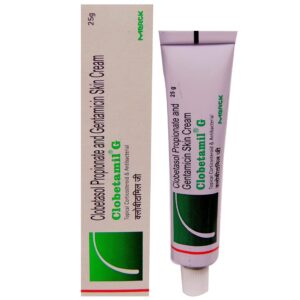GENTAMYCIN + CLOBETASOL
Gentamycin: Gentamicin is an antibiotic drug commonly used to treat bacterial infections. It belongs to the class of drugs known as aminoglycosides. It is typically administered via injection and is used to treat a wide range of bacterial infections, including those affecting the respiratory system, urinary tract, skin, bones, and other parts of the body.
The mechanism of action of gentamicin involves interfering with the synthesis of bacterial proteins. It binds to the bacterial ribosomes, inhibiting protein synthesis and ultimately leading to cell death.
The dosing of gentamicin can vary depending on the specific infection being treated, the patient’s weight, and kidney function. The drug is typically administered intravenously or intramuscularly. The dosage is usually divided into multiple daily doses, with the timing and duration of therapy determined by the severity and type of infection.
As with any medication, gentamicin can cause side effects. Common side effects include nausea, vomiting, diarrhea, and loss of appetite. It may also cause kidney damage and hearing loss (ototoxicity), particularly with prolonged use or higher doses. To minimize the risk of these adverse effects, the drug is usually administered under careful monitoring and with periodic assessments of kidney function and hearing.
It’s important to note that gentamicin should only be used to treat bacterial infections and is ineffective against viral or fungal infections. It should also be used with caution in patients with pre-existing kidney or hearing problems.
Overall, gentamicin is a valuable antibiotic used to treat various bacterial infections. However, its use should be guided by a healthcare professional, taking into account the individual patient’s condition and potential risks.
Clobetasol: Clobetasol is a potent corticosteroid medication. It is commonly used topically to treat various skin conditions such as psoriasis, eczema, dermatitis, and lichen planus. It helps to reduce inflammation, itching, and redness associated with these conditions.
The mechanism of action of clobetasol involves binding to glucocorticoid receptors in the skin cells. This activates certain genes that control the production of inflammatory substances, leading to a decrease in inflammation, itching, and other symptoms.
Clobetasol is available in different formulations such as creams, ointments, lotions, and solutions. The dosage and duration of treatment depend on the specific condition being treated and the severity of symptoms. It is generally recommended to apply a thin layer of the medication to the affected area once or twice daily. It is important to follow the instructions provided by the healthcare professional or the product label.
Like all corticosteroids, clobetasol may cause certain side effects. Common side effects may include skin dryness, burning or stinging sensation, itching, and skin irritation at the application site. These side effects are usually mild and temporary. However, if these side effects persist or worsen, it is important to consult a healthcare professional.
Long-term use or excessive use of clobetasol can lead to more serious side effects such as skin thinning, stretch marks, acne, changes in skin color, and absorption of the medication into the bloodstream causing systemic side effects. It is therefore important to use clobetasol as directed and avoid prolonged use without medical supervision. It should not be applied to the face, groin, or underarms unless specifically prescribed by a healthcare professional.
It is important to inform the healthcare professional about any other medications, supplements, or medical conditions before using clobetasol to avoid potential drug interactions or contraindications. Pregnant or breastfeeding women should consult their healthcare professional before using clobetasol.
Overall, clobetasol is an effective topical corticosteroid that can help alleviate symptoms of various skin conditions. However, it should be used under medical supervision and for short-term use to minimize the risk of side effects.

